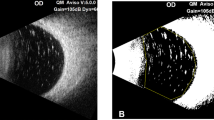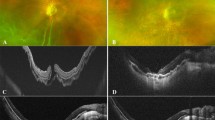Abstract
Purpose
To investigate the risk factors associated with retinal detachment recurrence after first vitrectomy in high myopic eyes with macular hole retinal detachment (MHRD).
Methods
Patients with high myopic eyes with MHRD who underwent pars plana vitrectomy and silicone oil (SO) tamponade with a follow-up period more than 12 months and more than 3 months after SO removal were included in this retrospective study. Logistic regression was performed to determine the risk factors associated with retinal re-detachment.
Results
A total of 45 eyes from 43 patients were included in this study (11 male and 34 female patients). The retinal re-detachment rate after the first removal of silicon oil was 35.5% (16/45) in a mean postoperative follow-up time of 35.64 ± 32.94 months. Complete macular atrophy on fundus photography (odds ratio (OR) = 17.021, 95% confidence interval (95% CI): 2.218–130.609, p = 0.006) was a risk factor for MHRD after SO removal, while internal limiting membrane (ILM) peeling (OR = 0.091, 95% CI: 0.013–0.633, p = 0.015) and duration of SO tamponade (OR = 0.667, 95% CI: 0.454–0.980, p = 0.039) were protective factors.
Conclusion
For high myopic eyes with MHRD, complete macular atrophy was a significant risk factor for retinal re-detachment after silicon oil removal. ILM peeling and the duration of silicon oil tamponade were protective factors.
Similar content being viewed by others
Log in or create a free account to read this content
Gain free access to this article, as well as selected content from this journal and more on nature.com
or
Data availability
The datasets used during the current study are available from the corresponding author on reasonable request. Informed consent for publication of the clinical dataset from participants has been obtained.
References
Sasoh M, Yoshida S, Ito Y, Matsui K, Osawa S, Uji Y. Macular buckling for retinal detachment due to macular hole in highly myopic eyes with posterior staphyloma. Retina. 2000;20:445–9.
Miyake Y. A simplified method of treating retinal detachment with macular hole. Am J Ophthalmol. 1984;97:243–5.
Wolfensberger TJ, Gonvers M. Long-term follow-up of retinal detachment due to macular hole in myopic eyes treated by temporary silicone oil tamponade and laser photocoagulation. Ophthalmology. 1999;106:1786–91.
Gonvers M, Machemer R. A new approach to treating retinal detachment with macular hole. Am J Ophthalmol. 1982;94:468–72.
Scholda C, Wirtitsch M, Biowski R, Stur M. Primary silicone oil tamponade without retinopexy in highly myopic eyes with central macular hole detachments. Retina. 2005;25:141–6.
Michalewska Z, Michalewski J, Adelman RA, Nawrocki J. Inverted internal limiting membrane flap technique for large macular holes. Ophthalmology. 2010;117:2018–25.
Chen SN, Yang CM. Inverted internal limiting membrane insertion for macular hole-associated retinal detachment in high myopia. Am J Ophthalmol. 2016;162:99–106.e101.
Caporossi T, Pacini B, De Angelis L, Barca F, Peiretti E, Rizzo S. Human amniotic membrane to close recurrent, high myopic macular holes in pathologic myopia with axial length of >30 mm. Retina. 2019. https://doi.org/10.1097/IAE.0000000000002699.
Chen YP, Chen TL, Yang KR, Lee WH, Kuo YH, Chao AN, et al. Treatment of retinal detachment resulting from posterior staphyloma-associated macular hole in highly myopic eyes. Retina. 2006;26:25–31.
Ohno-Matsui K, Kawasaki R, Jonas JB, Cheung CM, Saw SM, Verhoeven VJ, et al. International photographic classification and grading system for myopic maculopathy. Am J Ophthalmol. 2015;159:877–83.e7.
Ruiz-Medrano J, Montero JA, Flores-Moreno I, Arias L, Garcia-Layana A, Ruiz-Moreno JM. Myopic maculopathy: current status and proposal for a new classification and grading system (ATN). Prog Retin Eye Res. 2019;69:80–115.
Schulze-Bonsel K, Feltgen N, Burau H, Hansen L, Bach M. Visual acuities “hand motion” and “counting fingers” can be quantified with the freiburg visual acuity test. Invest Ophthalmol Vis Sci. 2006;47:1236–40.
Nishimura A, Kimura M, Saito Y, Sugiyama K. Efficacy of primary silicone oil tamponade for the treatment of retinal detachment caused by macular hole in high myopia. Am J Ophthalmol. 2011;151:148–55.
Meng L, Wei W, Li Y, Han X, Shi X, Yang M. Treatment of retinal detachment secondary to macular hole in highly myopic eyes: pars plana vitrectomy with internal limiting membrane peel and silicone oil tamponade. Retina. 2014;34:470–6.
Nakanishi H, Kuriyama S, Saito I, Okada M, Kita M, Kurimoto Y, et al. Prognostic factor analysis in pars plana vitrectomy for retinal detachment attributable to macular hole in high myopia: a multicenter study. Am J Ophthalmol. 2008;146:198–204.
Xie A, Lei J. Pars plana vitrectomy and silicone oil tamponade as a primary treatment for retinal detachment caused by macular holes in highly myopic eyes: a risk-factor analysis. Curr Eye Res. 2013;38:108–13.
Teke MY, Balikoglu-Yilmaz M, Yuksekkaya P, Citirik M, Elgin U, Kose T, et al. Surgical outcomes and incidence of retinal redetachment in cases with complicated retinal detachment after silicone oil removal: univariate and multiple risk factors analysis. Retina. 2014;34:1926–38.
Choudhary MM, Choudhary MM, Saeed MU, Ali A. Removal of silicone oil: prognostic factors and incidence of retinal redetachment. Retina. 2012;32:2034–8.
Mancino R, Ciuffoletti E, Martucci A, Aiello F, Cedrone C, Cerulli L, et al. Anatomical and functional results of macular hole retinal detachment surgery in patients with high myopia and posterior staphyloma treated with perfluoropropane gas or silicone oil. Retina. 2013;33:586–92.
Hong N, Huang BS, Tong JP. Primary silicone oil tamponade and internal limiting membrane peeling for retinal detachment due to macular hole in highly myopic eyes with chorioretinal atrophy. BMC Ophthalmol. 2015;15:165.
Fang Y, Yokoi T, Shimada N, Du R, Shinohara K, Takahashi H, et al. Development of macular atrophy after pars plana vitrectomy for myopic traction maculopathy and macular hole retinal detachment in pathologic myopia. Retina. 2019. https://doi.org/10.1097/IAE.0000000000002709.
Laidlaw DA, Karia N, Bunce C, Aylward GW, Gregor ZJ. Is prophylactic 360-degree laser retinopexy protective? Risk factors for retinal redetachment after removal of silicone oil. Ophthalmology. 2002;109:153–8.
Acknowledgements
We thank Dong Chongya for his help in statistical analysis and American Journal Experts (AJE) for providing medical English editing for this manuscript.
Funding
The study was supported by Capital clinical diagnosis and treatment technology research and demonstration application project of China (Grant Z191100006619029) and the Research Fund for Science and Technology Program of Beijing (No. Z161100000516037). The funders had no role in the study design, data collection and analysis, decision to publish or preparation of the paper.
Author information
Authors and Affiliations
Corresponding authors
Ethics declarations
Conflict of interest
The authors declare that they have no conflict of interest.
Ethical approval
This retrospective study was approved by the Peking University People’s Hospital Review Board and adhered to the tenets of the Declaration of Helsinki and Health Insurance Portability and Accountability Act.
Informed consent
Written informed consent was obtained from all individual participants included in the study.
Additional information
Publisher’s note Springer Nature remains neutral with regard to jurisdictional claims in published maps and institutional affiliations.
Rights and permissions
About this article
Cite this article
Li, M., Tang, J., Jia, Z. et al. Long-term follow-up of primary silicone oil tamponade for retinal detachment secondary to macular hole in highly myopic eyes: a prognostic factor analysis. Eye 35, 625–631 (2021). https://doi.org/10.1038/s41433-020-0922-0
Received:
Revised:
Accepted:
Published:
Issue date:
DOI: https://doi.org/10.1038/s41433-020-0922-0



